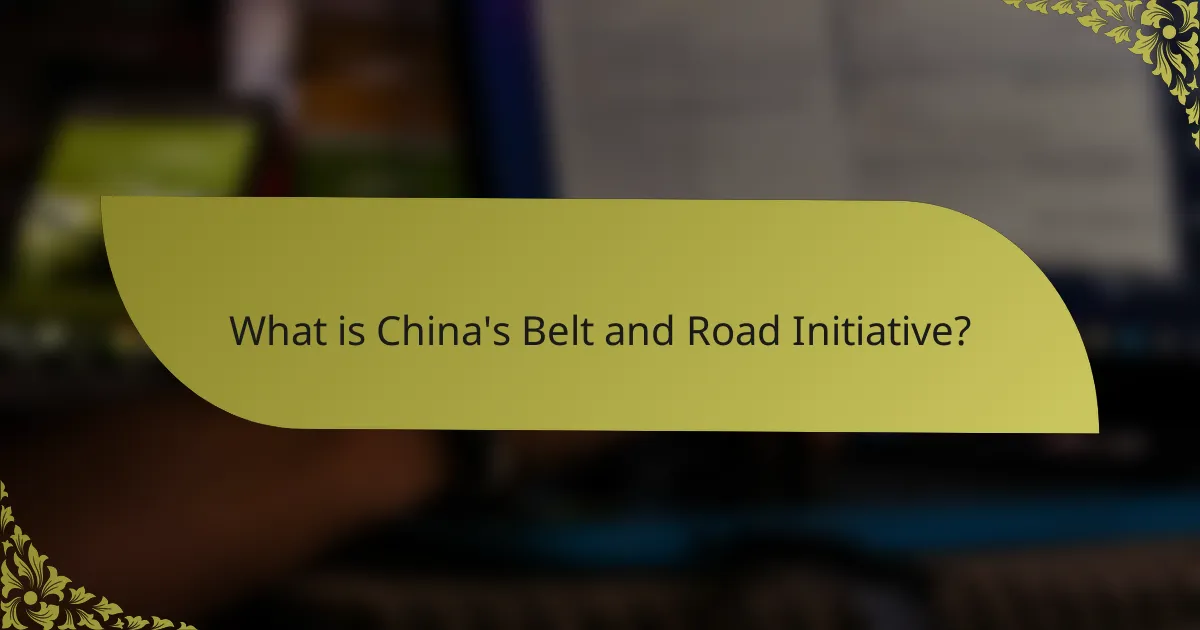China’s Belt and Road Initiative (BRI) is a comprehensive global development strategy initiated in 2013, aimed at enhancing regional connectivity and fostering economic growth through extensive infrastructure investments. The BRI encompasses over 140 countries, focusing on critical sectors such as infrastructure, energy, trade, telecommunications, and real estate. Key partnerships, particularly with nations in Asia, Europe, and Africa, facilitate significant funding and collaboration on projects like the China-Pakistan Economic Corridor. By promoting trade and improving logistics, the BRI aspires to create a modern Silk Road, thereby expanding China’s influence and securing vital trade routes. The initiative is supported by financial institutions like the Asian Infrastructure Investment Bank, which plays a crucial role in funding these developments.

What is China’s Belt and Road Initiative?
China’s Belt and Road Initiative (BRI) is a global development strategy launched in 2013. It aims to enhance regional connectivity and embrace a brighter economic future through infrastructure development. The initiative involves investments in railways, highways, ports, and energy projects across Asia, Europe, and Africa. It seeks to promote trade and stimulate economic growth by creating a modern Silk Road. The BRI encompasses over 140 countries and aims to foster international collaboration. By 2021, it was estimated that BRI projects involved over $1 trillion in investments. The initiative reflects China’s ambition to expand its influence and secure trade routes.
How does the Belt and Road Initiative impact global trade?
The Belt and Road Initiative (BRI) significantly impacts global trade by enhancing connectivity among participating countries. It aims to improve infrastructure through investments in roads, railways, and ports. This initiative facilitates trade by reducing transportation costs and time. According to the World Bank, improved infrastructure can increase trade by up to 15%. The BRI promotes economic integration, allowing countries to access new markets. It also encourages foreign direct investment, which boosts local economies. Furthermore, the initiative strengthens trade relationships between China and partner countries. As of 2021, over 140 countries have signed agreements related to the BRI. This widespread participation indicates its substantial influence on global trade dynamics.
What are the key components of the Belt and Road Initiative?
The key components of the Belt and Road Initiative (BRI) include infrastructure development, trade facilitation, and investment cooperation. Infrastructure development focuses on building roads, railways, ports, and energy projects across participating countries. Trade facilitation aims to enhance connectivity and reduce trade barriers among nations involved in the initiative. Investment cooperation encourages financial collaboration between China and partner countries to support various projects. The BRI also emphasizes cultural exchange and policy coordination to strengthen ties. These components are designed to promote economic growth and regional integration across Asia, Europe, and Africa. The initiative was launched in 2013 and includes over 140 countries as participants.
How do infrastructure projects facilitate trade under the initiative?
Infrastructure projects under China’s Belt and Road Initiative facilitate trade by enhancing connectivity and reducing transportation costs. Improved roads, railways, and ports enable faster movement of goods across borders. This increased efficiency attracts investments and stimulates economic growth in participating countries. For instance, the construction of the China-Pakistan Economic Corridor has significantly reduced travel time for freight. Additionally, these projects foster trade partnerships by linking markets and promoting regional integration. As a result, trade volumes among participating nations have risen, demonstrating the initiative’s effectiveness in boosting economic collaboration.
What economic goals does the Belt and Road Initiative aim to achieve?
The Belt and Road Initiative aims to enhance global trade and economic development. It seeks to improve infrastructure connectivity across Asia, Europe, and Africa. The initiative promotes investments in transportation, energy, and telecommunications. By fostering trade routes, it intends to increase economic cooperation among participating countries. The initiative also aims to create new markets for Chinese goods and services. Additionally, it focuses on establishing financial partnerships to support development projects. This approach is expected to stimulate economic growth in both China and partner nations. The initiative represents a strategic effort to expand China’s influence globally.
How does the initiative promote economic development in participating countries?
The initiative promotes economic development in participating countries through infrastructure investment and trade facilitation. It focuses on building roads, railways, and ports. These developments enhance connectivity between nations. Improved infrastructure reduces transportation costs and time. This leads to increased trade volumes. The initiative also encourages foreign direct investment. It creates job opportunities in local economies. Enhanced trade routes stimulate local industries and services. Overall, the initiative fosters economic growth and development in the regions involved.
What are the expected long-term economic impacts of the initiative?
The expected long-term economic impacts of China’s Belt and Road Initiative include enhanced trade connectivity and increased foreign investment. The initiative aims to create a network of infrastructure projects across Asia, Europe, and Africa. This infrastructure development is projected to facilitate smoother trade routes. Improved transport links can lead to reduced shipping times and costs. Studies indicate that countries participating in the initiative may experience GDP growth. For instance, a report by the Asian Development Bank suggests that BRI could increase regional GDP by 1.7% annually. Additionally, the initiative may attract investments in sectors such as energy and transportation. This influx of capital can stimulate job creation and economic diversification. Overall, the long-term impacts are anticipated to foster economic resilience among participating nations.

What investment opportunities arise from the Belt and Road Initiative?
The Belt and Road Initiative (BRI) presents various investment opportunities across multiple sectors. Infrastructure development is a primary focus, with investments in roads, railways, and ports. Countries participating in the BRI require significant funding for these projects. The Asian Infrastructure Investment Bank (AIIB) has been established to finance such developments, raising over $100 billion in capital.
Energy projects also offer substantial opportunities. Investments in renewable energy sources and oil and gas pipelines are prioritized. For instance, the China-Pakistan Economic Corridor has attracted billions for energy infrastructure.
Trade and logistics are enhanced through improved connectivity. Investments in logistics hubs and trade facilitation measures increase efficiency. This leads to greater regional trade volumes and economic growth.
Telecommunications is another sector ripe for investment. The BRI encourages the expansion of digital infrastructure. This includes fiber optic networks and mobile communication systems.
Real estate development is also a key area. Urbanization in BRI countries creates demand for housing and commercial properties. Chinese companies are actively investing in real estate projects in various regions.
In summary, the Belt and Road Initiative offers diverse investment opportunities in infrastructure, energy, trade, telecommunications, and real estate. These sectors are crucial for the economic development of participating countries.
Which sectors are most attractive for investment within the initiative?
Infrastructure, energy, and technology sectors are most attractive for investment within China’s Belt and Road Initiative. Infrastructure projects include roads, railways, and ports, which facilitate trade and connectivity. The energy sector focuses on renewable energy, oil, and gas projects, crucial for sustainable development. Technology investments encompass telecommunications and digital infrastructure, enhancing communication and innovation. According to the Asian Development Bank, investments in these sectors are expected to exceed $26 trillion by 2030. This growing demand reflects the initiative’s emphasis on enhancing global economic integration and development.
What role do public-private partnerships play in investment opportunities?
Public-private partnerships (PPPs) facilitate investment opportunities by combining resources and expertise from both sectors. They enable governments to leverage private sector efficiency and innovation. In the context of China’s Belt and Road Initiative, PPPs attract foreign investment in infrastructure projects. For instance, the Asian Development Bank reported that PPPs can mobilize up to $1.5 trillion annually for infrastructure development. This collaboration reduces public financial burdens while enhancing project delivery and management. Additionally, PPPs foster risk-sharing, making investments more appealing to private entities. Overall, PPPs are crucial in expanding investment avenues within the Belt and Road framework.
How can investors assess risk and return in Belt and Road projects?
Investors can assess risk and return in Belt and Road projects by evaluating several key factors. They should analyze the political stability of participating countries. Political risks can significantly affect project viability. Economic conditions and growth potential in these regions are also crucial. Understanding local market dynamics helps gauge potential returns.
Investors must consider the legal frameworks governing investments. Regulatory risks can impact project execution and profitability. Additionally, assessing the project’s financing structure is vital. The sources of funding and repayment terms influence financial stability.
Finally, examining historical data on similar projects provides valuable insights. Past performance can indicate potential future returns and risks. Overall, a comprehensive analysis of these factors enables informed investment decisions in Belt and Road projects.
What are the financing mechanisms available for investors?
Investors have several financing mechanisms available under China’s Belt and Road Initiative. These mechanisms include government-backed loans, public-private partnerships, and equity investments. Government-backed loans often come from institutions like the Asian Infrastructure Investment Bank. Public-private partnerships enable collaboration between governments and private investors for infrastructure projects. Equity investments allow investors to acquire stakes in projects for potential returns. Additionally, multilateral development banks support financing through grants and loans. The combination of these mechanisms facilitates funding for large-scale projects across participating countries.
How do multilateral banks support investments in the initiative?
Multilateral banks support investments in China’s Belt and Road Initiative by providing financial resources and expertise. They offer loans and grants to fund infrastructure projects associated with the initiative. For instance, the Asian Development Bank has committed billions to improve transportation and energy networks. These banks also facilitate risk-sharing among participating countries. They promote policy dialogue to enhance investment climates. Additionally, they provide technical assistance to ensure project viability. Their involvement helps mobilize private sector investment through blended finance models. This support strengthens regional connectivity and economic integration.
What alternative financing options exist for Belt and Road projects?
Alternative financing options for Belt and Road projects include multilateral development banks, private sector investments, and public-private partnerships. Multilateral development banks, like the Asian Infrastructure Investment Bank (AIIB), provide funding for infrastructure projects. Private sector investments can supplement government funding, bringing in capital from corporations and investors. Public-private partnerships leverage both public resources and private expertise, sharing risks and rewards. Additionally, bilateral agreements between countries can facilitate financing through direct loans or grants. These options enhance project viability and reduce reliance on traditional financing sources.

What strategic partnerships are formed through the Belt and Road Initiative?
The Belt and Road Initiative (BRI) forms strategic partnerships primarily with countries in Asia, Europe, and Africa. These partnerships aim to enhance infrastructure development and economic collaboration. Key partnerships include agreements with Pakistan for the China-Pakistan Economic Corridor. Additionally, China has established partnerships with countries like Russia and Italy to promote trade and investment. The initiative also engages with Central Asian nations to strengthen connectivity. Evidence of these partnerships can be seen in the numerous infrastructure projects funded by China across participating countries. The BRI has led to increased trade volumes and investment flows between China and partner nations.
Which countries are key partners in the Belt and Road Initiative?
Key partners in the Belt and Road Initiative include over 140 countries. Notable partners are Pakistan, Russia, and Italy. Other significant countries involved are Malaysia, Indonesia, and Kenya. These nations participate through various projects and investments. The initiative aims to enhance trade and infrastructure development. It connects Asia, Europe, and Africa through land and maritime routes. The scale of investment in these countries reflects their strategic importance.
How do geopolitical factors influence partnerships within the initiative?
Geopolitical factors significantly influence partnerships within China’s Belt and Road Initiative. Countries’ political stability affects their willingness to engage in partnerships. For example, nations with strong governance are more likely to collaborate on infrastructure projects. Additionally, regional conflicts can deter investment and cooperation. The presence of trade agreements also shapes partnerships. Countries that share trade ties with China may find it easier to join the initiative. Moreover, geopolitical alliances impact funding and support for projects. Nations aligned with China politically often receive preferential treatment in partnerships. Historical relationships also play a crucial role in determining collaboration levels. Countries with a history of cooperation are more inclined to participate in the initiative.
What collaborative frameworks exist between China and partner countries?
Collaborative frameworks between China and partner countries primarily include the Belt and Road Initiative (BRI). The BRI aims to enhance infrastructure connectivity and promote economic cooperation across Asia, Europe, and Africa. It involves investment in transportation, energy, and telecommunications projects. China has established bilateral agreements with various countries to facilitate trade and investment. Additionally, multilateral cooperation frameworks, such as the Asian Infrastructure Investment Bank (AIIB), support funding for development projects. The BRI has seen participation from over 140 countries, indicating its global reach. These frameworks are designed to foster mutual economic growth and strengthen diplomatic ties.
What roles do international organizations play in the initiative?
International organizations play crucial roles in China’s Belt and Road Initiative (BRI). They facilitate funding and investment through financial support mechanisms. Organizations like the Asian Infrastructure Investment Bank (AIIB) provide loans for infrastructure projects. They also promote policy coordination among participating countries. Additionally, international organizations help in setting standards for projects, ensuring sustainability and compliance. They foster regional cooperation and dialogue, enhancing diplomatic relations. Furthermore, they provide technical assistance and expertise to improve project implementation. Overall, their involvement enhances the effectiveness and reach of the initiative.
How do these organizations facilitate cooperation among countries?
Organizations involved in China’s Belt and Road Initiative facilitate cooperation among countries through infrastructure development, trade agreements, and cultural exchanges. They promote connectivity by funding and constructing roads, railways, and ports. This infrastructure enhances trade routes and reduces transportation costs. Additionally, these organizations negotiate trade agreements that lower tariffs and encourage investment. They also foster cultural exchanges, which build mutual understanding and trust among nations. Collaborative projects often involve multiple countries, reinforcing partnerships. The Asian Infrastructure Investment Bank, for instance, finances projects that support regional development. These efforts collectively strengthen economic ties and political relations across participating countries.
What impact do they have on the effectiveness of the initiative?
The effectiveness of China’s Belt and Road Initiative (BRI) is significantly impacted by strategic partnerships. These partnerships enhance investment flows and facilitate infrastructure development across participating countries. Collaborative efforts lead to shared resources and expertise, increasing project success rates. For instance, countries involved in the BRI report improved trade connectivity and economic growth. According to a report by the Asian Development Bank, BRI investments have the potential to increase GDP in participating countries by up to 3.4%. Effective partnerships also foster political stability, which is crucial for long-term project sustainability. Therefore, the quality and strength of these partnerships directly influence the overall success of the BRI.
What are best practices for engaging with the Belt and Road Initiative?
Establishing strong partnerships is a best practice for engaging with the Belt and Road Initiative. Collaborating with local stakeholders enhances project success. Conducting thorough risk assessments is essential to identify potential challenges. Aligning projects with local development goals ensures mutual benefits. Utilizing transparent communication fosters trust among all parties involved. Adopting sustainable practices minimizes environmental impacts and promotes long-term viability. Continuous monitoring and evaluation of projects help in adjusting strategies as needed. Engaging with international standards enhances credibility and attracts further investment.
China’s Belt and Road Initiative (BRI) is a global development strategy launched in 2013, aimed at enhancing regional connectivity through infrastructure investments across Asia, Europe, and Africa. The initiative involves over 140 countries and seeks to promote trade, stimulate economic growth, and secure trade routes, with projected investments exceeding $1 trillion. Key components include infrastructure development, trade facilitation, and investment cooperation, which collectively enhance global trade dynamics and foster economic development in participating nations. Additionally, the BRI presents various investment opportunities across sectors such as energy, telecommunications, and real estate, while forming strategic partnerships that influence geopolitical relationships and collaborative frameworks.



